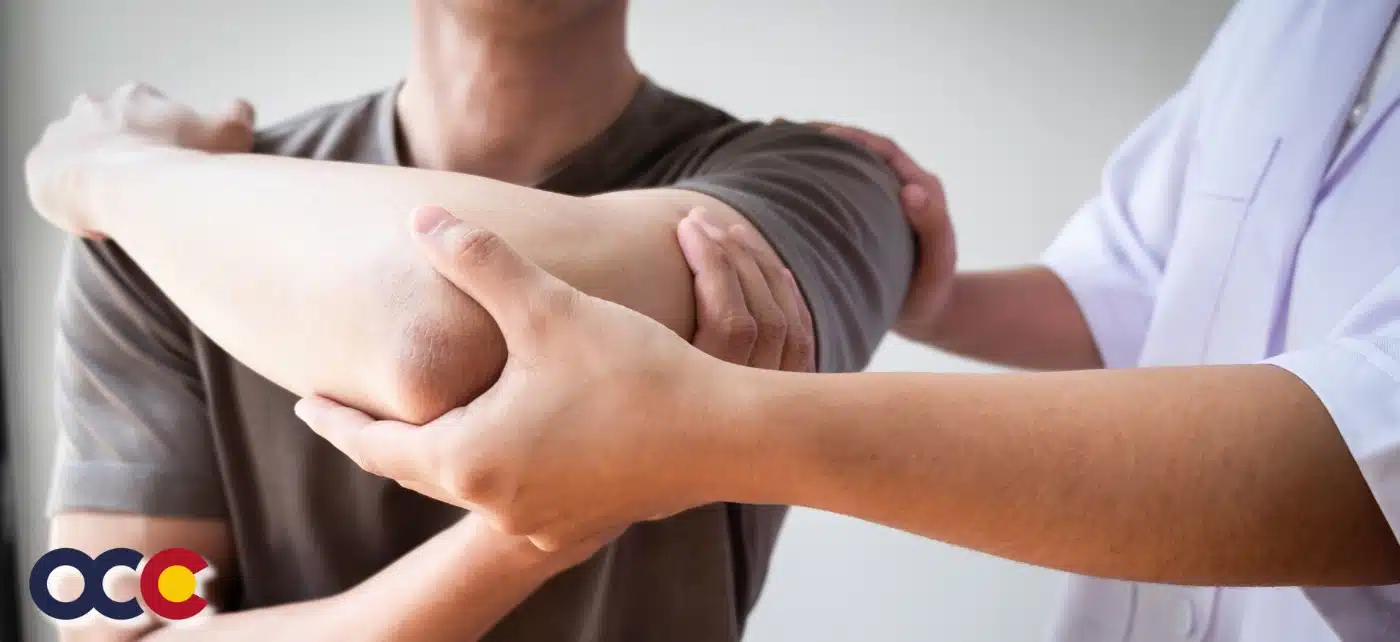Shoulder replacement surgery is a procedure that is done to reduce pain and restore overall shoulder mobility. There are several types of shoulder replacement surgery, the most common include: reverse shoulder replacement, partial shoulder replacement and shoulder resurfacing.
As with many surgical procedures, shoulder replacement surgery is often highly successful, but typically pursued only after other non-surgical options have been exhausted. Before recommending surgery, your orthopedic surgeon will want to ensure you are a good candidate and determine which type of surgery is best for you. A few of the most common types of shoulder replacement surgery include:
Total shoulder replacement surgery
The traditional shoulder replacement procedure has been done in the United States for more than 70 years[1] and replaces a person’s natural “ball and socket” shoulder structure.
In this procedure, the damaged shoulder parts, commonly known as the “ball” and “socket” are replaced with prostheses (artificial parts). The socket, where the shoulder blade connects to the top of the arm bone, known as the humorous, receives a prosthetic cup and then is reconnected to a metal ball that has replaced the end of the humorous.
This procedure relies on a healthy rotator cuff muscle to stabilize and move the shoulder upon recovery.
Reverse shoulder replacement (also known as reverse total shoulder arthroplasty)
A reverse shoulder replacement is often recommended when there has been a major rotator cuff tear or deterioration (often due to arthritis), causing those muscles not to work properly anymore. In this procedure, the ball and socket arrangement are reversed, which allows for the deltoid muscle to control movement of the shoulder post-surgery instead of the rotator cuff. In this set-up, instead of being attached to the humorous, the metal ball is affixed to the damaged socket, while a socket-shaped cup replaces the ball at the top of the arm bone.
Partial shoulder replacement
There are a couple of types of partial shoulder replacement. The first, known informally as a “ream and run,” keeps the natural socket intact and only replaces the head of the humorous (the “ball”) with a prosthetic ball. If needed, the surgeon will also reshape or smooth the socket tissue to ensure the best possible shoulder joint movement for the new ball.
The second common type of partial shoulder replacement is known as shoulder resurfacing. In this procedure, rather than removing the damaged head of the humorous, it is topped with a round cap to improve joint movement. The natural socket also remains in place.
When should I consider shoulder replacement surgery?
No matter which type of shoulder replacement is best for your condition, shoulder replacement surgery is often considered when there has been severe trauma, such as a shoulder fracture, or for those whose arthritis has progressed considerably. In these cases, other treatments, such as physical therapy, ice, rest, NSAIDs (non-steroidal anti-inflammatory drugs, like Advil) or cortisone shots are no longer effective at maintaining range of motion and minimizing pain. Patients often have severe stiffness, limited range of motion and even a grinding sensation when they move their arm.
While shoulder replacement surgery is highly successful for most patients, there are some circumstances when the procedure should not be pursued. These include but are not limited to people who have who have more severe impairment of both the rotator cuff and deltoid muscles, those recovering from an active infection, and people who have a progressive nervous system disease such as Parkinson’s.
Qualified orthopedic surgeons work closely with each patient, using physical examination, review of symptoms and overall health, and imaging resources such as an Xray, CT scan or MRI to make case-by-case recommendations. If nerve damage is suspected, an EMG test may also be conducted.
Preparing for surgery
How you prepare for shoulder replacement surgery can impact your recovery experience and timeline. Your level of fitness, weight and other factors all play a part in improving your outcome and minimizing your recovery time.
In addition, plan to have friends or family members available to take you and bring you home and give you support in the first few days or weeks post-operation. Expect to have limited strength and range of motion at first while you begin to heal. Don’t forget to plan support for everyday essentials immediately after the procedure, such as bathing, dressing, laundry, driving etc.
Shoulder replacement surgery is typically completed in a hospital or surgical center and most procedures take a couple of hours or less. After surgery, some patients are able to head home the same day, while others remain in the hospital for a few days.
Naturally, patients feel some pain after surgery, most can be managed with mild pain relievers (NSAIDs) or local anesthetics. Surgeons recommend minimizing the use of opioid pain relievers, which are highly addictive.
Recovery after shoulder replacement surgery
Your surgeon will provide specific instructions, such as what to wear post-surgery (hint: a button up shirt is often easiest to put on after the procedure) and send you home in a sling, which will protect your shoulder for the first 2-4 weeks as it heals. You will also need to take care of the incision site, keeping it clean and dry as it heals.
Depending on the type and nature of the surgery, it can take three to six months to fully heal. During that time, physical and/or occupational therapy is extremely valuable to help regain strength and ensure full mobility. Many patients are referred to therapy almost immediately after surgery. Your surgeon will likely provide a home exercise plan for the first few weeks and then may recommend working with a professional therapist as you progress.
Many patients enjoy a noticeable reduction in pain after surgery but take care not to overdo it during recovery. Avoid lifting anything heavy or using your arm to push yourself up to a sitting or standing position. Doing so puts too much pressure on the incision point. Patients should avoid many household tasks and driving for up to a month, so asking for help is essential.
Shoulder replacement surgery can significantly improve quality of life for people who’ve suffered from pain and limited range of motion. If you’re considering your options, see one of our board-certified orthopedic surgeons for a recommendation:
[av_heading heading=’Best Shoulder Replacement Surgeons’ tag=’h3′ style=” subheading_active=” show_icon=” icon=’ue800′ font=” size=” av-medium-font-size-title=” av-small-font-size-title=” av-mini-font-size-title=” subheading_size=’15’ av-medium-font-size=” av-small-font-size=” av-mini-font-size=” icon_size=” av-medium-font-size-1=” av-small-font-size-1=” av-mini-font-size-1=” color=” custom_font=” icon_color=” margin=” margin_sync=’true’ padding=’10’ icon_padding=’10’ link=” link_target=” id=” custom_class=” av_uid=’av-kke98yj8′ admin_preview_bg=”][/av_heading]
[av_one_third first min_height=” vertical_alignment=” space=” custom_margin=” margin=’0px’ padding=’0px’ border=” border_color=” radius=’0px’ background_color=” src=” background_position=’top left’ background_repeat=’no-repeat’ animation=” mobile_breaking=” mobile_display=” av_uid=’av-q082ph’]
[av_image src=’https://advancedortho.org/wp-content/uploads/2013/01/ferrari_feature1.png’ attachment=’789′ attachment_size=’full’ align=’center’ styling=” hover=” link=” target=” caption=” font_size=” appearance=” overlay_opacity=’0.4′ overlay_color=’#000000′ overlay_text_color=’#ffffff’ copyright=” animation=’no-animation’ av_uid=’av-jhhxhm0t’ custom_class=” admin_preview_bg=”][/av_image]
[av_textblock size=” font_color=” color=” av-medium-font-size=” av-small-font-size=” av-mini-font-size=” av_uid=’av-jhhxeat7′ custom_class=” admin_preview_bg=”]
Dr. James Ferrari
[/av_textblock]
[av_button label=’Meet Dr. Ferrari’ link=’post,587′ link_target=” size=’small’ position=’center’ label_display=” icon_select=’yes’ icon=’ue80a’ font=’entypo-fontello’ color=’theme-color’ custom_bg=’#444444′ custom_font=’#ffffff’ av_uid=’av-jhhxi5li’ custom_class=” admin_preview_bg=”]
[/av_one_third]
[av_one_third min_height=” vertical_alignment=” space=” custom_margin=” margin=’0px’ padding=’0px’ border=” border_color=” radius=’0px’ background_color=” src=” background_position=’top left’ background_repeat=’no-repeat’ animation=” mobile_breaking=” mobile_display=” av_uid=’av-dnizjp’]
[av_image src=’https://advancedortho.org/wp-content/uploads/2013/01/motz_feature1.png’ attachment=’795′ attachment_size=’full’ align=’center’ styling=” hover=” link=” target=” caption=” font_size=” appearance=” overlay_opacity=’0.4′ overlay_color=’#000000′ overlay_text_color=’#ffffff’ copyright=” animation=’no-animation’ av_uid=’av-jhhxncdx’ custom_class=” admin_preview_bg=”][/av_image]
[av_textblock size=” font_color=” color=” av-medium-font-size=” av-small-font-size=” av-mini-font-size=” av_uid=’av-jhhxeat7′ custom_class=” admin_preview_bg=”]
Dr. H. Andrew Motz
[/av_textblock]
[av_button label=’Meet Dr. Motz’ link=’post,601′ link_target=” size=’small’ position=’center’ label_display=” icon_select=’yes’ icon=’ue80a’ font=’entypo-fontello’ color=’theme-color’ custom_bg=’#444444′ custom_font=’#ffffff’ av_uid=’av-jhhxntha’ custom_class=” admin_preview_bg=”]
[/av_one_third]
[av_one_third min_height=” vertical_alignment=” space=” custom_margin=” margin=’0px’ padding=’0px’ border=” border_color=” radius=’0px’ background_color=” src=” background_position=’top left’ background_repeat=’no-repeat’ animation=” mobile_breaking=” mobile_display=” av_uid=’av-8yi0wl’]
[av_image src=’https://advancedortho.org/wp-content/uploads/2013/01/papillion_feature1.png’ attachment=’797′ attachment_size=’full’ align=’center’ styling=” hover=” link=” target=” caption=” font_size=” appearance=” overlay_opacity=’0.4′ overlay_color=’#000000′ overlay_text_color=’#ffffff’ copyright=” animation=’no-animation’ av_uid=’av-jhhxslv7′ custom_class=” admin_preview_bg=”][/av_image]
[av_textblock size=” font_color=” color=” av-medium-font-size=” av-small-font-size=” av-mini-font-size=” av_uid=’av-jhhxeat7′ custom_class=” admin_preview_bg=”]
Dr. John Papilion
[/av_textblock]
[av_button label=’Meet Dr. Papilion’ link=’post,605′ link_target=” size=’small’ position=’center’ label_display=” icon_select=’yes’ icon=’ue80a’ font=’entypo-fontello’ color=’theme-color’ custom_bg=’#444444′ custom_font=’#ffffff’ av_uid=’av-jhhxt1oa’ custom_class=” admin_preview_bg=”]
[/av_one_third]
[1] Source: https://orthoinfo.aaos.org/en/treatment/shoulder-joint-replacement/
















